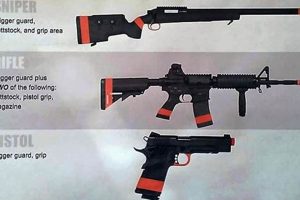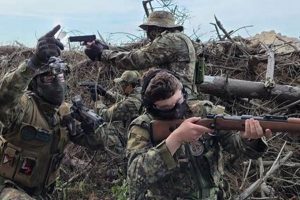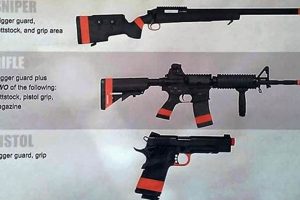Regulations governing the possession and use of airsoft guns within Canada are primarily dictated by the Firearms Act and Criminal Code. These legislative instruments classify airsoft devices based on their velocity and overall resemblance to real firearms, influencing their legality and required permits.
Adherence to these guidelines is essential for both individuals and businesses involved in the sale, distribution, and use of these recreational items. Understanding the nuances prevents legal complications and contributes to public safety by ensuring responsible handling and storage.
The subsequent sections will delve into specific aspects such as classification, storage requirements, transportation protocols, and provincial variations that affect the operation of airsoft activities across the country.
The following tips provide essential guidance for compliance with the regulations governing airsoft activities within Canada.
Tip 1: Know the Velocity Limits: Airsoft guns exceeding 366 feet per second are classified as firearms. Possession requires appropriate licensing and registration, mirroring the requirements for actual firearms.
Tip 2: Understand the Resemblance Clause: Airsoft devices that closely resemble real firearms may be subject to stricter regulations, even if velocity is below the firearm threshold. Ensure modifications do not enhance realism beyond acceptable levels.
Tip 3: Safe Storage is Mandatory: Store airsoft guns unloaded and securely, out of reach of unauthorized individuals, particularly minors. Secure storage can prevent accidental misuse and potential legal ramifications.
Tip 4: Transportation Procedures are Crucial: When transporting, keep airsoft guns in a locked case or container, preferably separate from ammunition or power sources. Make certain they are not readily accessible from the passenger compartment of a vehicle.
Tip 5: Provincial Laws May Vary: Be aware that provinces and municipalities may have supplementary bylaws or regulations regarding the use of airsoft guns. Research local laws prior to engaging in airsoft activities in a new location.
Tip 6: Verify Field Compliance: Organized airsoft fields and events may have their own rules and regulations beyond legal requirements. Adhere to these site-specific rules without exception.
Tip 7: Legal Updates are Important: Laws related to airsoft guns are subject to change. Regularly consult the Firearms Act and Criminal Code of Canada for the most current information.
Following these tips provides a foundation for responsible and legal airsoft participation, safeguarding both the individual and the community.
The subsequent conclusion will further emphasize the importance of responsible conduct and continued vigilance regarding regulatory changes.
1. Velocity thresholds
The establishment of velocity thresholds is a cornerstone of Canadian airsoft legislation. The Criminal Code defines airsoft guns based, in part, on their ability to project a projectile. Devices propelling projectiles at velocities exceeding 366 feet per second (FPS), as measured with a .20 gram projectile, are classified as firearms under Canadian law. This classification triggers the requirements for licensing, registration, and storage applicable to conventional firearms. Non-compliance results in potential criminal charges, including possession of an unregistered firearm.
This threshold directly impacts the airsoft market. Manufacturers must adhere to these velocity limits to ensure legality. Retailers must verify the velocity of imported devices and communicate these specifications to consumers. Airsoft field operators are responsible for verifying the velocity of participants’ devices to prevent the use of illegally modified or overpowered airsoft guns on their premises. A real-life example is the seizure of airsoft guns at the border due to exceeding the FPS threshold, resulting in prosecution for attempting to import undeclared firearms. The practical significance lies in the individual responsibility to ascertain and comply with the law before purchasing, using, or modifying any airsoft device.
In summary, velocity thresholds are integral in defining the boundary between a regulated recreational item and a controlled firearm within the Canadian legal framework. The challenge lies in consistent enforcement and clear communication to the public. Understanding this relationship is essential for avoiding legal repercussions and promotes the responsible enjoyment of airsoft as a recreational activity within the bounds of Canadian law.
2. Realistic imitation
The degree to which an airsoft gun resembles a real firearm is a significant factor within regulations. This aspect focuses on visual similarities and the potential for misuse arising from such resemblances. The goal is to prevent confusion and potential criminal activities.
- Visual Cues and Similarity
Airsoft guns with nearly identical dimensions, markings, and coloring to genuine firearms face increased scrutiny. Manufacturers and importers need to ensure visual differences exist. Example: A black airsoft replica of a Glock handgun, without any distinguishing markings, falls under this category. Implications involve seizure by customs or law enforcement.
- Potential for Public Alarm
Openly displaying or brandishing an airsoft gun that is indistinguishable from a real firearm may create public alarm, resulting in police intervention. Courts may view it as a factor in aggravating charges related to public disturbance or threats. Example: Carrying an airsoft rifle without a case in a public park. This could lead to charges depending on local circumstances and interpretation by law enforcement.
- Criminal Misuse Risk
Realistic airsoft guns can be used to intimidate or commit crimes, leading to enhanced penalties if the weapon is perceived as real. Even if no actual weapon is used, the presence of a replica influences sentencing. Example: Using a realistic airsoft pistol during a robbery, even if unloaded. This can lead to charges identical to using a real firearm in the commission of a crime.
- Modifications and Alterations
Altering an airsoft gun to more closely resemble a real firearm is actively discouraged and potentially illegal. Removing orange tips, adding trademarks of real firearm manufacturers, or modifying the externals can violate regulations. Example: Painting an airsoft gun black, removing orange markings, and adding manufacturer logos to create a more authentic appearance. These modifications may lead to seizure and possible charges.
Realistic imitation is not solely a visual concern; it encompasses the potential for misuse, public perception, and the overall risk of confusion with actual firearms. Regulations are designed to minimize these risks, requiring vigilance from manufacturers, retailers, and users of airsoft guns to ensure compliance. These restrictions reflect a focus on public safety and preventing criminal activity, reinforcing the importance of responsible handling and modification of these recreational devices.
3. Safe storage
Safe storage of airsoft guns is a critical aspect of Canadian law. Regulations emphasize secure storage to prevent accidental access, theft, and misuse, contributing to overall public safety.
- Legal Mandate for Securing Devices
Canadian airsoft legislation requires unloaded airsoft guns to be stored securely, out of sight and reach of unauthorized individuals, especially minors. This mandate stems from the Firearms Act and Criminal Code, influencing how airsoft devices are handled within private residences. Example: Leaving an airsoft rifle unsecured in a closet accessible to children violates this mandate and may lead to charges of negligent storage. This requirement directly relates to preventing accidental injuries and unauthorized use.
- Storage Methods and Acceptable Practices
Acceptable safe storage includes locked cases, cabinets, or rooms. Airsoft guns must be stored unloaded and, ideally, separated from ammunition or power sources. Example: Storing airsoft pistols in a locked gun safe, separate from magazines and BBs, fulfills the safety requirement. Storing batteries separately also minimizes risk of accidental activation. The level of security should match the potential risk and the ease of access to the device.
- Consequences of Non-Compliance
Failure to comply with safe storage regulations can result in legal penalties, including fines, imprisonment, and loss of the right to possess firearms. If an improperly stored airsoft gun is used in a crime or causes injury, the owner may face criminal charges related to negligent storage. Example: An airsoft gun stolen from an unlocked car used in a robbery leads to charges for the owner due to improper storage, in addition to the robbery perpetrator’s charges. The severity of consequences underscores the need for strict adherence.
- Responsibility and Due Diligence
Ultimately, the onus of responsibility for safe storage lies with the owner or person in control of the airsoft gun. Demonstrating due diligence by adhering to storage requirements mitigates legal risks. Example: Documenting storage practices, such as keeping records of locked containers and restricted access, provides evidence of responsible handling. Owners must demonstrate a commitment to responsible storage, reflecting intent to prevent misuse.
These facets highlight the intersection between legal requirements and responsible ownership. Strict adherence to these regulations enhances public safety and minimizes legal liabilities. The connection between safe storage and regulations reinforces the accountability of individuals regarding these recreational devices.
4. Transportation rules
Transportation of airsoft guns within Canada is governed by a specific subset of regulations. These rules are inextricably linked to Canadian airsoft laws, functioning as a practical extension of existing firearm legislation. The core objective is preventing airsoft guns from being mistaken for, or misused as, actual firearms during transit. These restrictions mitigate risks associated with public alarm, potential theft, and unlawful deployment.
These regulations mandate that airsoft guns must be transported in a manner that prevents immediate use and minimizes public visibility. Typically, this requires the device to be unloaded, rendered inoperable (e.g., battery removed), and stored within a locked case or container. The container should be opaque, preventing visual identification of the contents. Ammunition, magazines, and propellant sources should be transported separately. Example: A failure to transport an airsoft rifle in a locked case resulted in charges related to improper transport of a firearm, despite its non-lethal nature. This incident highlights the severity of non-compliance.
In summary, transportation rules constitute a crucial component. They function to ensure responsible handling and transport to limit visibility. These requirements reduce both the risk of misuse, and the chance that the device is incorrectly identified. This adherence promotes public safety and mitigates legal liabilities, reinforcing the critical role of responsible practices when handling airsoft guns.
5. Provincial bylaws
While the Firearms Act and Criminal Code of Canada establish the baseline regulations for airsoft guns, provincial bylaws introduce an additional layer of complexity and localized control. These bylaws often address specific concerns or conditions unique to each province or municipality, impacting how airsoft activities are conducted. Consequently, understanding provincial and municipal regulations is as important as grasping federal laws.
- Discharge Restrictions in Municipalities
Some provinces or municipalities may have bylaws restricting the discharge of airsoft guns within city limits or populated areas. These regulations might specify permissible locations, such as designated airsoft fields or private property with adequate safety measures. For instance, a city bylaw might prohibit discharging an airsoft gun within 100 meters of a public park or school. Violation of these bylaws can result in fines or confiscation of the device.
- Age Restrictions and Parental Supervision
Provinces can implement age restrictions that differ from federal guidelines regarding the possession or use of airsoft guns. Certain jurisdictions may require parental supervision for individuals under a specified age, even if federal regulations do not explicitly mandate it. For example, a provincial law might state that individuals under 16 must be accompanied by an adult when using an airsoft gun at a public range. Failure to comply could lead to liability for both the minor and the supervising adult.
- Transportation and Storage within City Limits
Municipal bylaws might impose additional requirements for the transportation and storage of airsoft guns within city boundaries. These regulations can be more stringent than provincial or federal laws, prescribing specific methods of securing the device during transport or storage within residential areas. For example, a city might require that airsoft guns be stored in a locked container and disassembled during transportation, regardless of whether it is carried in a vehicle or on foot. Violations carry municipal fines and potential confiscation of the airsoft gun.
- Definition and Classification Variations
While federal law defines airsoft guns based on velocity and resemblance to real firearms, some provincial or municipal bylaws may introduce nuanced definitions or classifications. These variations could affect which devices are subject to specific regulations within that jurisdiction. For instance, a municipality might define “replica firearms” more broadly than federal law, encompassing a wider range of airsoft guns and subjecting them to stricter controls. This discrepancy requires careful consideration when interpreting and adhering to both federal and local requirements.
Therefore, provincial bylaws, encompassing discharge restrictions, age limitations, transportation protocols, and definition variations, significantly shape the overall regulatory landscape. These laws contribute to how individuals engage with airsoft activities across the country. Non-compliance with provincial and municipal laws can create significant legal complications, further emphasizing the essential need to be fully informed and compliant with all relevant requirements.
6. Field regulations
Field regulations, although not directly codified within the Firearms Act or the Criminal Code, represent a crucial extension of existing Canadian airsoft legislation. While federal and provincial laws establish the baseline legal framework governing the ownership, storage, and transportation of airsoft devices, field regulations address the specific operational parameters within dedicated airsoft facilities and events. These rules function as a necessary adaptation of broader legal principles to the unique environment of organized airsoft activities. A primary effect of field regulations is to enhance participant safety and minimize potential legal liabilities for field operators. For instance, velocity limits mandated by Canadian airsoft laws are typically enforced and even surpassed by stricter field-specific regulations to ensure player well-being. This highlights the importance of field rules as a practical implementation of overarching legislative intent.
The practical significance of understanding the relationship between field regulations and broader legislation lies in risk management and responsible gameplay. Field operators have a legal responsibility to provide a safe environment, and adherence to field rules is often a condition of participation. Failure to comply with these rules can result in expulsion from the field, potential legal action in case of injury, and damage to the reputation of the airsoft community. A real-life example could involve a player modifying their airsoft gun to exceed field velocity limits, causing injury to another participant. In such a scenario, both the player and potentially the field operator could face legal consequences, demonstrating the direct link between rule adherence and legal accountability. Moreover, most field rules exceed the minimum FPS set by federal law for a standard airsoft gun, demonstrating the critical need to comply with both legal regulations and field-specific instructions.
In conclusion, field regulations are a critical component of the overall regulatory landscape surrounding airsoft in Canada. While not legally mandated in the same manner as federal statutes, they serve as a vital mechanism for translating legislative intent into practical safety measures and ensuring responsible conduct within the airsoft community. The challenge lies in promoting consistent enforcement of field rules across different facilities and educating participants about the importance of adhering to both legal requirements and field-specific guidelines. This multifaceted approach to regulation fosters a safer and more responsible airsoft environment within Canada.
Frequently Asked Questions
The following represents common inquiries regarding the legal framework governing airsoft activities in Canada. These answers provide clarification on crucial aspects of the law.
Question 1: What defines an airsoft gun under Canadian law?
An airsoft gun is typically defined as a device that discharges a projectile, usually a plastic BB, using compressed gas or a spring mechanism. Crucially, the velocity of the projectile must not exceed 366 feet per second when measured with a .20 gram projectile for it to be classified as an airsoft gun and not a firearm.
Question 2: Are airsoft guns considered firearms in Canada?
Airsoft guns are not generally considered firearms under the Firearms Act, provided they meet specific criteria. If the device propels a projectile at a velocity exceeding 366 feet per second, or if it is designed or altered to discharge a projectile capable of causing serious bodily injury or death, it is then classified as a firearm. This classification mandates licensing and registration.
Question 3: Is a license required to own an airsoft gun in Canada?
A license is generally not required to own an airsoft gun that is not classified as a firearm. However, individuals should verify provincial and municipal bylaws, as these may impose additional restrictions or requirements.
Question 4: What are the regulations for transporting an airsoft gun?
Airsoft guns must be transported unloaded and securely contained, preferably in a locked case. They should not be readily accessible from the passenger compartment of a vehicle. Ammunition should be transported separately. These measures aim to prevent the device from being mistaken for a real firearm.
Question 5: Can airsoft guns be used anywhere in Canada?
The usage of airsoft guns is subject to both federal and provincial/municipal laws. Discharge is generally restricted in public areas. Usage is typically permitted only on private property with the owner’s consent or at designated airsoft fields. Check local bylaws for specific regulations.
Question 6: What are the potential consequences of violating regulations regarding airsoft guns?
Violations can result in fines, confiscation of the airsoft gun, and, in severe cases, criminal charges related to the possession of an unregistered firearm. If an airsoft gun is used in the commission of a crime, penalties may be significantly higher, potentially mirroring those for using a real firearm.
This FAQ provides an overview of key aspects of regulations. Understanding these is vital for responsible participation in the sport.
The succeeding section will delve into case law to further clarify points of ambiguities.
Canadian Airsoft Laws
This examination of regulations governing airsoft within Canada has highlighted the crucial interplay between federal statutes, provincial bylaws, and field-specific rules. The assessment has defined airsoft guns, explained velocity thresholds, emphasized safe storage and transportation protocols, and illuminated the significance of realistic imitation and provincial variations. The legal framework is multifaceted, requiring vigilance from all involved.
Continued awareness of evolving regulations and a commitment to responsible practices are paramount. Ensuring compliance, by understanding and adhering to the “Canadian Airsoft Laws,” contributes to public safety and secures the future of the sport. Further research and consultation with legal professionals are recommended to navigate the complexities of these regulations effectively.







